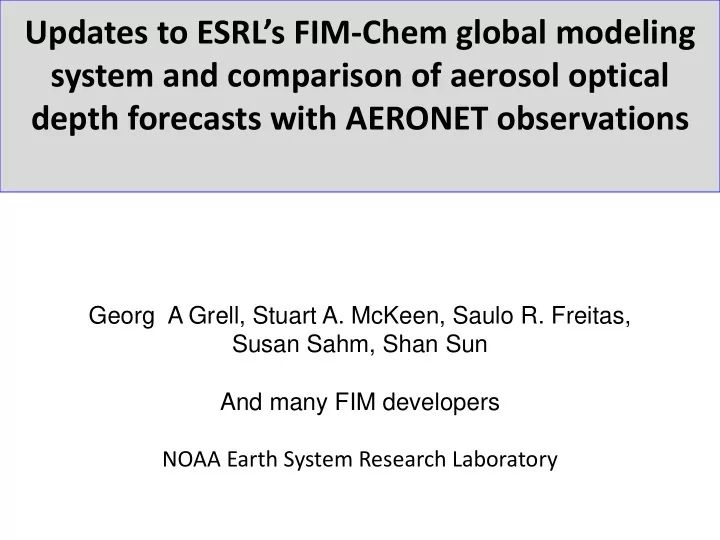

Updates to ESRL’s FIM-Chem global modeling system and comparison of aerosol optical depth forecasts with AERONET observations Georg A Grell, Stuart A. McKeen, Saulo R. Freitas, Susan Sahm, Shan Sun And many FIM developers NOAA Earth System Research Laboratory
Outline • Some slides on FIM-Chem development • Evaluation with AERONET data • Future plans 2
FIM: Flow-following- finite-volume Icosahedral Model Icosahedral horizontal grid Hybrid (sigma/ isentropic) vertical coordinate • Improved conservation using quasi- Nearly equal size of grid volumes, material surfaces, reduced vertical including near poles dispersion. Improved stratospheric/tropospheric exchange
Physics in FIM • Initially: GFS physics. Immediate goal for FIM is contributing dynamical-core diversity to NCEP Global Ensemble Forecast System • Need to show that FIM is at least comparable in skill to GFS • From Weather Research and Forecasting Modeling system (WRF): Cumulus parameterizations and Current skill scores are microphysics routines may slightly better than GFS be used • All Chemistry routines: From WRF
Chemistry: what is currently included (running in real-time) • Aerosol and simple sulfur chemistry modules from the Global Chemistry Aerosol Radiation and Transport (GOCART) model • 4-bin sea-salt from GOCART • 5-bin dust based on GOCART but after further development from AER/AFWA • Wildfire plume-rise • Volcanic ash and SO2 emissions, historic or in real- time • Dry and wet deposition, sub-grid scale transport Aerosol direct and semi-direct effect through interaction with radiation (online MIE calculations)
Simulating aerosol optical properties (AFWA project) • Three month period in 2010 to evaluate AOD predictions from FIM-Chem, 60 km global resolution, 2 runs per day for 24-hr forecasts, aerosols are cycled – GOCART aerosol modules, but new AFWA/AER dust model – Dust and sea-salt emissions online, anthropogenic emissions from RETRO/EDGAR .25 degree resolution global data set, fires from MODIS Satellite data – Comparison to AERONET observations as well as Satellite observations • 10 years of runs for AFWA • Optical routine that uses FIM-Chem and/or WRF-Chem output to provide aerosol optical properties and phase functions 10-year data set available for further examination
Time-series comparisons for 2 different FIM-Chem runs, August – October 2010 Dust Wildfires Anthropogenic emissions only 7
Comparison with AEONET data, No chemical data August through October 2010, 24 hr assimilation yet !! 8 forecasts, 11835 points
Example of Optics at 2 very different locations: Omaha Nebraska, and United Arab Emirates 550nm AOD Omaha 0.07 UAE 0.41 Omaha: PM 2.5 = 6.57 μg/m 3 , mostly Sulfate, with some Organics, Primary (unspeciated) (400m ASL) United Arab Emirates : PM 2.5 = 65.8 μg/m 3 , mostly Dust, a little Seasalt, and Sulfate
Some impact on weather forecast in real-time runs, even without data assimilation and/or tuning Spring 2012: Largest impact in Northern Hemisphere (fires and air pollution in SE Asia, widespread dust over Sahara and SW Asia) 500 hPa height anomaly correlation verification score - 7-day forecasts
Currently in progress future model development • Significant effort towards implementing data assimilation • Mariusz Pagowski is working on both, NCEP’s 3DVAR Grid point Statistical Interpolation (GSI) system as well as the EnKF approach developed by T. Hamill and J. Whittaker here at ESRL • The EnKF approach already works with WRF-Chem for AOD and in-situ observations. The plan is to use for FIM-Chem with AOD and/or AAOD • FIM was coupled with icosahedral version of HYCOM Ocean model and is currently being tested Icosahedral Ocean Model (iHYCOM) 11
The global annual net heatflux at the surface is close to zero in the coupled FIM atmospheric model and the iHYCOM ocean model. However, the regional biases in the ocean mixed layer temperature are too big. Investigation in radiation/cloud physics is going on.
Currently in progress future model development • Improving emissions: implementing regional data sets, already done for SE Asia (by Li Zhang) • A Convective parameterization that allows for aerosol indirect effect and smooth transition to cloud resolving scales (Grell and Freitas) • Plumerise for wildfires will be dependent on windshear Transition to non-hydrostatic model (no scale restriction) will also be coming, several version are already being tested here at ESRL as well as NCAR: NIM (ESRL development) and MPAS (NCAR) 13
The new GF scheme: • Use forcing ensembles (stability equilibrium, stability removal, low level vertical velocity, integrated moisture convergence) • Random number generator to perturb ensembles or use stochastic field to perturb ensembles or fields that forcing depends on • Entrainment/detrainment rates have been adjusted to give smooth normalized mass flux profiles (parabolic start-up and end). • Depending on surface heat and moisture fluxes, CAPE may optionally be increased or decreased similar to the method described in Jakob and Siebesma (2003) • Arakawa et al (2011) approach or subsidence spreading may be used for scale aware approach • GF may also use aerosol effect, transport of tracers, wet deposition, aqueous phase chemistry • Aerosols may interact through conversion rate of cloud water to rainwater as well as evaporation of raindrops
Example of aerosol interactions (Cumulus parameterization) with WRF simulations, difference fields of accumulated total and parameterized precipitation (clean – polluted) Parameterized Parameterized + resolved Dx=20 km
Smooth transition to cloud resolving scales: Idealized hurricane simulations with WRF, dx=27-9-3-1km Cloud tops at ~7km Height (km) Average cloud top at 3km Drying tendencies at 36hr ( deg/day) – averaged inner part of 1km domain
The 1D cloud model: including the environmental wind effect on cloud scale dilution- governing equations dynamics for W dynamics for U thermo- dynamics water vapor conservation Th cloud water conservation rain/ice conservation equation for radius size bulk microphysics See Freitas et al. (2010 ACP) for 1d cloud model comparisons with fully 3D ATHAM simulations
Future model development, but not in progress yet • Using physics and chemistry from NCAR climate model (also available through WRF-Chem) • Ozone chemistry and biogenic emissions • Aerosol indirect effect for microphysics 18
Questions? 19
Recommend
More recommend